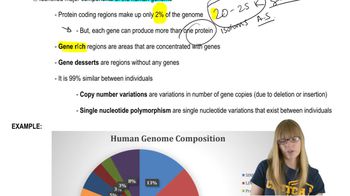Table of contents
- 1. Introduction to Genetics51m
- 2. Mendel's Laws of Inheritance3h 37m
- 3. Extensions to Mendelian Inheritance2h 41m
- 4. Genetic Mapping and Linkage2h 28m
- 5. Genetics of Bacteria and Viruses1h 21m
- 6. Chromosomal Variation1h 48m
- 7. DNA and Chromosome Structure56m
- 8. DNA Replication1h 10m
- 9. Mitosis and Meiosis1h 34m
- 10. Transcription1h 0m
- 11. Translation58m
- 12. Gene Regulation in Prokaryotes1h 19m
- 13. Gene Regulation in Eukaryotes44m
- 14. Genetic Control of Development44m
- 15. Genomes and Genomics1h 50m
- 16. Transposable Elements47m
- 17. Mutation, Repair, and Recombination1h 6m
- 18. Molecular Genetic Tools19m
- 19. Cancer Genetics29m
- 20. Quantitative Genetics1h 26m
- 21. Population Genetics50m
- 22. Evolutionary Genetics29m
15. Genomes and Genomics
Genomics and Human Medicine
Problem 25a
Textbook Question
Textbook QuestionA number of mouse models for human cystic fibrosis (CF) exist. Each of these mouse strains is transgenic and bears a different specific CFTR gene mutation. The mutations are the same as those seen in several varieties of human CF. These transgenic CF mice are being used to study the range of different phenotypes that characterize CF in humans. They are also used as models to test potential CF drugs. Unfortunately, most transgenic mouse CF strains do not show one of the most characteristic symptoms of human CF, that of lung congestion. Can you think of a reason why mouse CF strains do not display this symptom of human CF?
 Verified Solution
Verified SolutionThis video solution was recommended by our tutors as helpful for the problem above
Video duration:
1mPlay a video:
300
views
Was this helpful?
Related Videos
Related Practice


